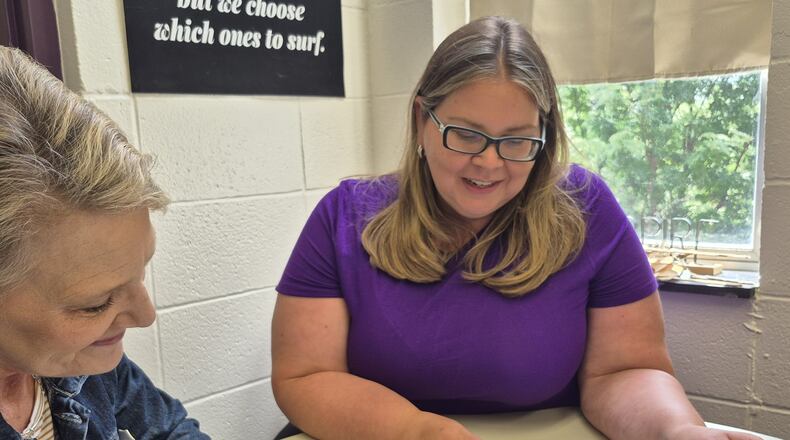“It’s always busiest at the beginning of the school year,” Viel said. “Students have been in a world all their own.”
For mental health professionals such as Viel, the start of the school comes with an increased caseload as students and their families adjust to new stresses.
A 2023 study by the Centers for Disease Control and Prevention found that emergency department visits by children age 10 to 17 for mental and behavioral health conditions increased an average of 54% between summer and fall each year from 2018 to 2023.
According to the National Institute of Mental Health, 32% of people age 13 to 18 experience an anxiety disorder in their lifetime.
Viel said students come to her at the start of the school year with a wide variety of concerns, from deep fears of being friendless to the seemingly simple worry of not being able to find their way around a new building.
“It can be the little things that sets a kid off,” she said.
All cases are handled with the ultimate goal of not trying to stop anxiety, but to teach the students to cope with it.
Increased caseloads at the start of the school year aren’t limited to those professionals in a school setting.
Dr. Steve Liptak as been working with students and families for 34 years. He’s been a child psychologist with Premier Health’s Upper Valley Outpatient Behavioral Health since 1998.
Each year he sees the same concerns come through his door as soon as the first school bell rings.
What will my classes be like? Will my friends be in my class? Will the other students like me? All the unknowns that come with the start of something new.
“Every year, we always see an increase,” Liptak said. “It’s a transition time. What is anxiety? It’s a fear of the unknown.”
Liptak said he’s seen a “leveling off” in the influx of patients that came with the COVID-19 pandemic, thanks in part to the growth of telehealth. According to a 2022 study by the National Center of Education Statistics, 69% of public schools reported an increase in the number of students seeking metal health services as a result of the pandemic.
What Liptak said he does continue to see is a “dramatic” rise in the number of young adults working through issues stemming from social media.
“All of that has been magnified with social media,” he said. “This has become a huge extra level of stress for students and parents.”
Students he works with are spending six to 10 hours a day in front a screen outside of whatever they’re doing for school.
Increased anxiety during back to school isn’t limited to the students, he said.
“Some of these families, I’ve had the conversation for five years,” he said.
His advice to parents: a strong commitment to being a leader to their kid, and stifling the rescue instinct.
Children will take their cues from their caregiver’s emotional state, he said. So it the parent seems nervous about back to school, so will the student.
“If you want to manage your child’s anxiety, start with your own,” Dr. Liptak said.
Dr. Carly Schweier is a pediatric psychologist with Dayton Children’s Hospital whose work centers around abused and neglected children between the ages of 4 and 22.
She said referrals start increasing as schools open their doors, in part because there are more people watching the children.
“During the summer, kids aren’t necessarily seen by mandatory reporters,” Schweier said.
Teachers, school resource officers and guidance counselors are legally required to report suspected child abuse or neglect to authorities such as county health agencies or law enforcement.
Anxiety and depression can manifest in a lot of different ways, she said. Her advice to caregivers is to keep an open dialogue with their children and take changes in behaviors seriously.
“Even if it seems silly to us as a parent, it’s important to them,” Schweier said.
Extreme depression can lead a child to think about suicide or plan for suicide, according to the Center for Disease Control. Suicide is the second leading cause of death for people age 10 to 34.
Intentional self-harm was the top inpatient diagnosis at Dayton Children’s Hospital in 2023.
7 tips to dealing with back-to-school anxiety
- Get back into routines before school starts and start limiting screen time a few weeks before the first day of school.
- Check in with stress levels - parents and children alike.
- Listen to your children and validate their thoughts and feelings.
- Prepare for what you can - anxiety thrives in uncertainty.
- Create a “cope ahead” plan. Think of way for a child to envision how they can react to something that makes them anxious at school.
- Talk to school mental health professionals, especially if a child has significant anxiety or a mental health diagnosis.
- Blend back to school with fun activities.
Source: Anxiety and Depression Association of America
About the Author


